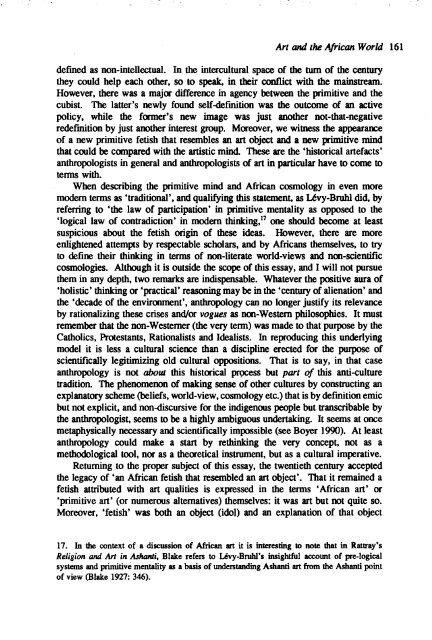1991 No. 1 CONTENTS - Institute of Social and Cultural ...
1991 No. 1 CONTENTS - Institute of Social and Cultural ...
1991 No. 1 CONTENTS - Institute of Social and Cultural ...
You also want an ePaper? Increase the reach of your titles
YUMPU automatically turns print PDFs into web optimized ePapers that Google loves.
Art <strong>and</strong> the African World 161<br />
defmed as non-intellectual. In the intercultural space <strong>of</strong> the turn <strong>of</strong> the century<br />
they could help each other, so to speak, in their conflict with the mainstream.<br />
However, there was a major difference in agency between the primitive <strong>and</strong> the<br />
cubist. The latter's newly found self-defmition was the outcome <strong>of</strong> an active<br />
policy, while the former's new image was just another not-that-negative<br />
redefmition by just another interest gI'O\Ip. Moreover, we witness the appearance<br />
<strong>of</strong> a new primitive fetish that resembles an art object <strong>and</strong> a new primitive mind<br />
that could be canpared with the artistic mind. These are the 'historical artefacts'<br />
anthropologists in general <strong>and</strong> anthropologists <strong>of</strong> art in particular have to come to<br />
tenns with.<br />
When describing the primitive mind <strong>and</strong> African cosmology in even more<br />
modem terms as 'traditional', <strong>and</strong> qualifying this statement, as Uvy-Bruhl did, by<br />
referring to 'the law <strong>of</strong> participation' in primitive mentality as opposed to the<br />
'logical law <strong>of</strong> contradiction' in modem thinldng,17 one should become at least<br />
suspicious about the fetish origin <strong>of</strong> these ideas. However, there are more<br />
enlightened attempts by respectable scholars, <strong>and</strong> by Mricans themselves, to try<br />
to define their thinldng in terms <strong>of</strong> non-literate world-views <strong>and</strong> non-scientific<br />
cosmologies. Although it is outside the scope <strong>of</strong> this essay, <strong>and</strong> I will not pursue<br />
them in any depth, two remarks are indispensable. Whatever the positive aura <strong>of</strong><br />
'holistic' thinking or 'practical' reasoning may be in the 'century <strong>of</strong> alienation' <strong>and</strong><br />
the 'decade <strong>of</strong> the environment', anthropology can no longer justify its relevance<br />
by rationalizing these crises <strong>and</strong>Ior vogues as om-Western philosophies. It must<br />
remember that the non-Westerner (the very term) was made to that purpose by the<br />
Catholics, Protestants, Rationalists <strong>and</strong> Idealists. In reproducing this underlying<br />
model it is less a cultural science than a discipline erected for the purpose <strong>of</strong><br />
scientifically legitimizing old cultural oppositions. That is to say, in that case<br />
anthropology is not about this historical prQCess but part <strong>of</strong> this anti-culture<br />
tradition. The phenomenon <strong>of</strong> making sense <strong>of</strong> other cultures by constructing an<br />
explanatory scheme (beliefs, world-view, cosmology etc.) that is by defmition emic<br />
but not explicit, <strong>and</strong> non-discursive for the indigenous people but transcribable by<br />
the anthropologist, seems to be a highly ambiguous undertaking. It seems at once<br />
metaphysically necessary <strong>and</strong> scientifically impossible (see Boyer 1990). At least<br />
anthropology could make a start by rethinking the very concept, not as a<br />
methodological tool, nor as a theoretical instrument, but as a cultural imperative.<br />
Returning to the proper subject <strong>of</strong> this essay, the twentieth century accepted<br />
the legacy <strong>of</strong> 'an African fetish that resembled an art object'. That it remained a<br />
fetish attributed with art qualities is expressed in the terms 'African art' or<br />
'primitive art' (or numerous alternatives) themselves: it was art but not quite so.<br />
Moreover, 'fetish' was both an object (idol) <strong>and</strong> an explanation <strong>of</strong> that object<br />
17. In the context <strong>of</strong> a discussion <strong>of</strong> African art it is interesting to note that in Ratb'ay's<br />
Religion <strong>and</strong> Art in Asho.nJi, Blake refers to Uvy-Bruhl's inSightful accolDlt <strong>of</strong> pre-Iogical<br />
systems <strong>and</strong> primitive mentality as a basis <strong>of</strong> underst<strong>and</strong>ing Ashanti art from the Ashanti point<br />
<strong>of</strong> view (Blake 1927: 346). .
















